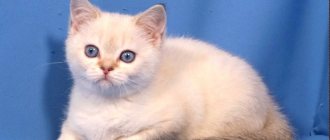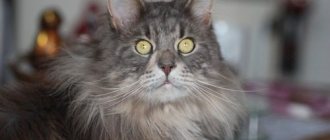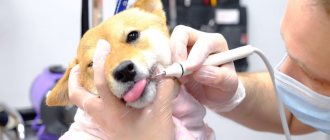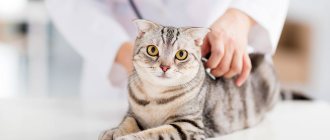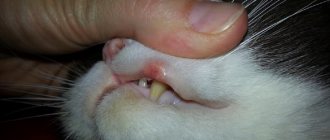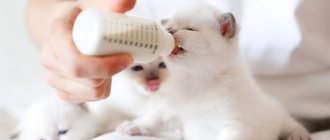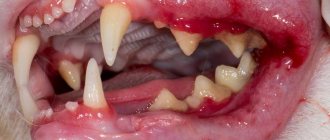Milk teeth in kittens
Kittens are born completely toothless. The first milk teeth erupt at the age of two weeks and differ from permanent teeth in their specific structure.
Structural features and differences from permanent teeth
Milk teeth in kittens are straight (in adult cats they are powerful and slightly curved) and have a milky white color (hence the name - milk teeth). In addition, they are sharp, like small needles.
Characteristic features are the primary canines, which erupt by the first month and change closer to five months. They are very thin and curved. In addition, on the inside of each fang there is a clearly visible second tooth, which falls out after the change.
In total, the kitten has twenty-six milk teeth. All of them should be fully formed by the age of two months: twelve incisors, four canines and ten small molars. Below is the dental formula of baby teeth.
For simplicity, veterinarians use dental formulas: incisors are designated by the letter I, canines - C, premolars - P, molars - M
If several or even one tooth is missing by the specified age, you should seek help from a veterinarian, since this problem may become a symptom of a more serious disease.
Table: timing of baby teeth eruption in kittens
| Teeth | Numbering | Timing of eruption |
| Incisors | I | 2–3 weeks |
| II | 2.5–4 weeks | |
| III | 3–4 weeks | |
| Fangs | 3–4 weeks | |
| Premolars | II | 8 weeks |
| III | 4–5 weeks | |
| IV | 4–6 weeks |
Causes of tooth loss in adult cats
If teeth fall out in adult cats, this is a clear sign of pathology. The most common cause is injury. A cat gets them when he tries to chew on inedible objects, crashes into furniture while playing, or fights with other animals. Injury can be caused by a person trying to pull out an object stuck in the teeth or take away prey.
Other causes of tooth loss:
- inflammatory gum diseases;
- pathologies of the immune system;
- diabetes;
- tumor lesions;
- hormonal imbalances.
If your cat's teeth fall out, you need to contact a veterinarian; this is always a sign that the animal is unhealthy.
Prevention of hair loss
To avoid tooth loss, you need to avoid creating traumatic situations and comprehensively monitor your cat’s health and diet. Ready-made super-premium food is preferred. Natural food is only useful when it is perfectly balanced to suit the cat’s needs, and this requires time and labor.
If a piece of food is stuck in a cat's teeth, remove it carefully, without loosening it and without sudden jerks. If this is not possible, it is better to consult a veterinarian.
In order to notice negative changes in time, your pet needs to be taken to the veterinarian for an examination every year. This is a comprehensive procedure that allows you to assess your general health and notice the onset of chronic diseases.
Situations where cats harm each other should not be allowed. Fights between pets should not be encouraged; on the contrary, they need to be separated and relationships between the tailed animals should be established. If a fang falls out in a fight, it will be difficult for the cat to eat and defend its place in feline society.
Changing baby teeth to permanent ones
At the age of three months, kittens begin to lose their milk teeth, gradually being replaced by molars . This process is usually complete by six or seven months, but don't worry if it takes longer for your kitten. Such deviations are usually associated with the breed of cat or characteristics of individual development.
The order of changing teeth should not be disturbed. The first to be replaced are the incisors, then the canines, and lastly the molars and premolars are replaced.
However, if a new tooth grows on a baby tooth and this causes discomfort to the pet, then you should definitely consult a specialist. If such growth does not bother the animal, then a visit to the veterinarian can be postponed, since baby teeth can calmly and painlessly fall out even after the main shift.
Teeth change schedule
A healthy adult cat should have thirty permanent teeth: twelve incisors, four canines, ten premolars and four molars. Each of them serves her for a specific purpose, for example, incisors are needed to tear food, fangs help to capture prey, and so on.
A cat's permanent dental formula is formed after six months. It includes: on top - three incisors, one canine, three premolars, one molar; below - three incisors, one canine, two premolars, one molar. When calculating, all coefficients are doubled, so the total is thirty permanent teeth.
This is what the jaw of an adult healthy cat should look like with timely and correct teeth replacement.
Table: schedule for the eruption of permanent teeth and their functions
| Teeth | Quantity (lower/upper jaw) | Period of eruption | Function |
| Incisors | 6/6 | 3.5–4.5 months | Grabbing |
| Fangs | 2/2 | 5 months | Tearing |
| Premolars | 6/4 | 4.5–6 months | Chopping |
| Molars | 2/2 | 4–5 months | Chopping |
Symptoms of tooth change
The process of changing teeth can begin and even end unnoticed by you, since the kitten usually does not experience pain. Most often, the change of teeth becomes obvious when a lost baby tooth is found.
Nevertheless, there are a number of symptoms that will help you navigate and notice in time the process of changing teeth:
- When a kitten's teeth change, an unpleasant odor may appear from the mouth, which is often associated with poor nutrition. There is no need to do anything about this, it will quickly disappear once the teeth renewal process is completed.
- Kittens may experience discomfort during the actual cutting of new teeth, so the animal's behavior will change slightly. For example, a slight increase in temperature is likely (the norm is a temperature of 38 ° C to 39 ° C, for small kittens a higher temperature of up to 39.5 ° C is typical). As a result, the kitten feels the cold more strongly and tries to spend more time next to the warm body of the owner: on the lap or in the arms. At night, pets can crawl under the covers, even if this was previously uncharacteristic for them.
If your pet suddenly loves lying under a blanket, this may be a sign of discomfort when changing teeth.
- You need to carefully ensure that the kitten does not swallow a lost tooth while eating. If this happens, you should not immediately run to the veterinarian; usually the tooth comes out naturally. However, it can also get stuck in the intestines, causing pain. The kittens then become aggressive and their temperature rises. In this case, you need to contact a specialist.
- During the period of teeth change, the pet will more often try to taste everything or chew on it in order to get rid of loose teeth.
Be very careful that your kitten does not start chewing wires or other objects that could harm him.
- From this moment on, cats begin to mark their territory.
- Redness of the gums may be observed, which is better to contact a specialist immediately so that chronic inflammation of the oral cavity does not begin.
- Sore gums can lead to refusal to eat. This is not a big deal, but if it lasts more than one to two days at most, you should change dry food to wet food, consulting your veterinarian first.
The author of these lines recently encountered the process of changing teeth in his kitten. Each animal exhibits specific symptoms, and when problems arise, it is easy for owners who know their animals to notice changes in behavior. So, my kitten usually did not hide under the blanket and did not play with some toys. When his teeth changed, he constantly chewed rubber sticks and tried to bite the scratching post. In this case, the baby teeth did not fall out immediately, but after the fangs were replaced.
Video: kitten teeth falling out
Symptoms of teething and changing teeth
In most cases, the period of teething and changing teeth in a kitten proceeds almost unnoticed by the owner, but there are a number of symptoms that the owner should pay attention to. And when they appear, for the health of the kitten and your own peace of mind, it is better to visit a veterinarian.
- Refusal to eat or decreased appetite.
If the gums are sore, the kitten may refuse solid food offered. In the event that the refusal to feed continues for more than a day, this should attract your attention.
- The kitten begins to bite toys, bedding, and the owner’s hands. Kitten owners should stop hand biting immediately because... this can lead to him developing a bad habit.
- There is a smell from the oral cavity (cat's bad breath).
READ Vitamin deficiency and hypovitaminosis in cats
In most cases, an unpleasant odor from the oral cavity appears when changing teeth. It is necessary to regularly examine the kitten's oral cavity, paying attention to severe redness or the appearance of ulcers on the mucous membrane.
- The molar has erupted, but the baby tooth has not yet fallen out
A similar situation in kittens occurs quite often and is explained by the fact that the molars grow from a different socket than the milk teeth. That is, physiologically, the molar does not “push out” the milk tooth. This situation shouldn't be scary for a while.
If the teeth in the oral cavity do not interfere with each other, the gums and mucous membrane of the oral cavity are not inflamed, owners should not worry. Not a single kitten in the world has a double set of teeth, which means that your kitten will sooner or later lose its “double set”. But if baby teeth interfere with the growth of molars, inflammation of the gums and oral mucosa occurs, and the teeth injure the tissues of the oral cavity, then the kitten’s owner will need to contact a veterinarian.
In both the first and second cases, cats have a desire to bite and chew. Toys, bedding, pillows or the hands of the owners are used. Biting a person's hands must be stopped, because... One-time actions can develop into a bad habit of biting them constantly.
There is no pain during the growth of teeth or their replacement, but some discomfort is present. Possible loss of appetite and increased salivation.
Loose baby teeth can disturb the pet, so you can see the cat shaking its head, actively licking or trying to get rid of it with its paw. There is no need to help, the animal will cope on its own!
When teeth are replaced with primary teeth, baby teeth may fall out or be swallowed. This phenomenon happens very often, but is not a cause for concern.
Caring for a kitten during the period of teeth change
The period of changing teeth can really become a test for an inexperienced owner. However, it is necessary to understand that the animal is not sick, does not need to take medications and constant visits from veterinarians. Most often, for a cat, everything happens, if not unnoticed, then at least painlessly.
There is no need to allow the kitten to chew furniture, spoil things, and especially not to bite and scratch you. In the future, this habit could become a really serious problem. Changing teeth is a natural process for an animal; therefore, the initially established rules of behavior must be preserved.
However, the task of every responsible owner is to make this period easier for the animal, take care of proper nutrition, brushing teeth and the availability of special toys.
Special food
A kitten needs proper and complete nutrition . However, despite the abundance of food created specifically for the period of teeth change, the animal may react negatively to a sudden change in food. Therefore, you need to ensure that your pet has the necessary vitamins and supplements in its diet, thanks to which permanent teeth will grow strong.
There are nutritional principles that must be followed when a kitten’s teeth change:
- First of all, you need to avoid overly soft food: kittens can swallow lost teeth along with soft food, which can lead to damage to the esophagus. The food should be large and slightly rough. Regular dry food for kittens is ideal.
Dry food is the best option during teeth change
- Large pieces of meat (beef, turkey, chicken, rabbit) scalded or boiled, cut into small pieces, are also ideal for a kitten.
- You need to include cottage cheese and other fermented milk products that are rich in calcium in your diet.
- The kitten needs calcium and phosphorus; they can be given as supplements to the main diet. At the pet store you can find both drops and small tablets that can be added to food. Such supplements also contain a little analgesic so that the kitten does not experience severe pain.
- A maximum of twice a week, you can give your kitten low-fat boiled sea fish, for example, hake. However, you should not overuse fish, even though it is rich in phosphorus.
- Meat or fish should be given mixed with cereals: oatmeal, buckwheat or rice. It is also useful to add some vegetables, such as carrots, zucchini or pumpkin, both raw and boiled.
- The diet should also include sufficient amounts of vitamins A and D.
- The kitten will try to chew everything, including your things, so it’s worth purchasing special bones. They contain the necessary vitamin supplements, and in fact the kitten gets the opportunity not only to strengthen its teeth, but also the necessary amount of vitamins supplied with saliva.
Bones are an important part of the diet and serve to prevent the kitten from chewing your things.
Veterinarians advise not to mix natural food (meat, fish, vegetables, etc.) and dry food. If you switched your kitten to dry food at an early age, then you should stick to it. The fact is that these types of food are digested differently, and when mixed, the kitten may experience bloating or even colic.
When choosing a feeding method, you should consult a veterinarian: each pet is individual, many may not be suitable for dry or natural food
Vaccination during the period of teeth change
Very often, owners are faced with an important question: is it possible to get vaccinations or other vaccinations while changing teeth? Veterinarians speak out unequivocally - changing teeth is already a serious burden for a kitten. Against the backdrop of fever and pain, getting vaccinated can be dangerous. This not only adversely affects the kitten’s immune system, but also leads to stunted growth of the animal.
Vaccination during the period of teeth change is not recommended.
It is important to follow the vaccination schedule for your pets as prescribed by your doctor. The vaccination schedule is set individually, taking into account the age characteristics of the body and physiological state.
My kitten was scheduled for the first vaccination very late. This was due to the fact that he was found on the street and many tests had to be done to assess his health. The time for his vaccination was due to change his teeth, so it had to be postponed for a while (until the temperature passed and slight inflammation of the gums subsided).
Teeth cleaning
Many owners ignore brushing their teeth. However, constant oral care will help keep your animal's teeth strong. It is necessary to accustom your cat to brushing its teeth from the early months of life so that in the future it will adequately perceive this procedure. If the cat refuses to accept traditional brushing with a toothbrush or powder, pet stores sell special gels for disinfecting the oral cavity. You can combine them with special foods and vitamins that include coarse fibers. It is recommended to brush your teeth once every three to four weeks.
Brushing your teeth is an important procedure that your kitten needs to be accustomed to.
During the change of teeth, kittens' gums can become inflamed, so you need to purchase a gel that also contains an anesthetic and anti-inflammatory, which can greatly alleviate your pet's condition.
How to care for your cat's permanent teeth
Let's be honest, many owners neglect to brush their cat's teeth. They treat purrs for various ailments, care for their fur, carry out parasite prevention, but completely forget about oral hygiene. And in vain, since dental diseases significantly worsen the quality of life of mustachioed and tailed friends.
It's time to take care of the cleanliness of tooth enamel when cats change their teeth to permanent ones. You don't need to do anything complicated to do this. It is enough just to brush your pet’s teeth at least once every two weeks (ideally once a week) using a special paste for animals (usually with the taste and aroma of meat or fish) and a miniature brush with a handle or one that fits on the index finger owner (instead of a brush, sometimes a piece of sterile bandage is used, which is also wrapped around the finger). In addition to the usual thick paste or gel for teeth, you can also remove plaque and tartar using liquid toothpaste for animals, which you simply need to add in a small amount to drinking water. This product can be a godsend for those pets who are afraid of brushing their teeth in the traditional way.
Dental care, by the way, can be provided not only with the help of special means. Dry food granules are good at removing plaque from teeth, so you should not constantly feed soft food and pates to pets accustomed to ready-made industrial products. Cats and female cats, when fed natural food, can be given fibrous meat and large bones with meat, as well as raw vegetables. All this also helps clean your teeth.
Possible complications during the period of teeth change
Changing teeth is a natural process that can occur without problems for the animal. However, during the period of active growth of molars, you should inspect the animal’s mouth at least once every few days. It is important to consider that reddish and slightly inflamed gums are normal. However, in some cases complications arise. A caring owner should notice the problem in time and be sure to contact a veterinarian.
The most common complications that are visible to the naked eye:
- Suppuration of the wound at the site of the lost tooth.
- The animal shows anxiety, meows pitifully, and may experience severe lethargy.
- The kitten refuses to eat for two days.
- Very severe inflammation of the gums.
- Wounds appear from a missing milk tooth, in the place of which a permanent tooth has already grown.
- Some of the baby teeth have not fallen out, although the permanent ones have already grown in and the time for changing teeth has already passed.
In these cases, you should take the kitten to the clinic or call a doctor at home.
Don't hesitate to contact your veterinarian, even if your pet doesn't show signs of restlessness, lethargy, etc. A healthy animal also needs control, so veterinarians are very loyal to owners who bring healthy animals for examination and ask to monitor the process of changing teeth.
Gum inflammation
Inflammation of the gums is one of the most common complications during the period of teeth change. A little inflammation is normal, but in some cases it lingers and the gums become red.
Inflamed gums become swollen and red
Signs of gum inflammation:
- the animal is restless;
- refuses to eat due to painful sensations;
- tries to chew more;
- rubs its muzzle against everything in an attempt to relieve pain;
- profuse salivation occurs;
- swelling and intense redness are noticeable.
Of course, it is better to have a veterinarian do the diagnosis and treatment, but gum inflammation may go away when the kitten is switched to softer food.
When is veterinary help needed?
Deterioration in health cannot always be attributed to the teeth; perhaps the pet is sick. A doctor's consultation will be required in the following situations:
- The smell becomes disgusting, which signals severe inflammation and the development of periodontal disease.
- The kitten sleeps poorly, does not eat for more than a day, and becomes apathetic or restless. A possible reason for this behavior is severe pain in the gums.
- Saliva is secreted excessively, thickens, hangs out of the mouth, which causes the fur on the chest to become wet. This indicates a possible inflammation of the oral mucosa - gingivitis, stomatitis.
The pet's mouth is regularly examined; normally, the surfaces remain smooth, pink, and without damage. Help is needed when deviations are noticed:
- the gum is inflamed around the temporary tooth;
- the hole festered;
- the “milk jug” has shifted and injures the mucous surfaces;
- some children’s teeth remain when the permanent ones are fully grown;
- after 7 months a double row was formed;
- The gums are red and bleeding.
In case of inflammation, they do not give medicine, but take the pet to the clinic. Only a veterinarian will be able to properly examine the mouth, assess the degree of inflammation, and prescribe medications without harm to the animal’s health. “Excess” teeth are removed in the clinic under anesthesia if they damage the mucous membranes, form an incorrect bite, or remain in the mouth after 8–9 months. Stunted growth, when milk has already fallen out, indicates a lack of microelements.
